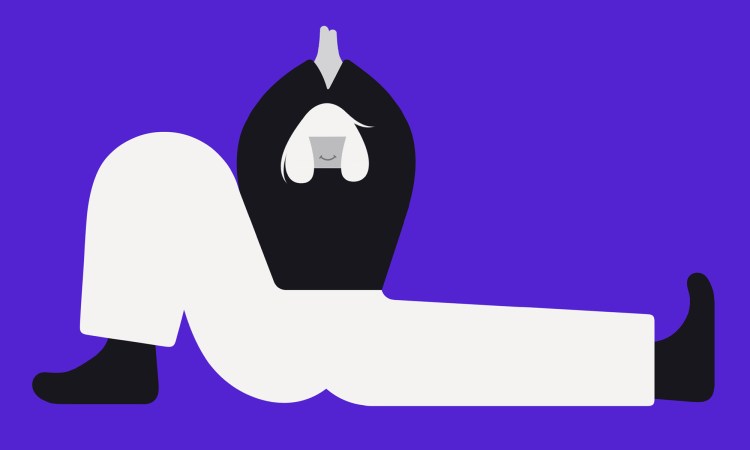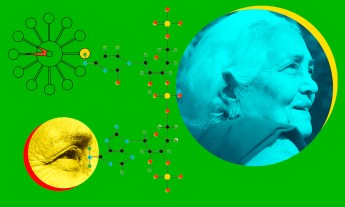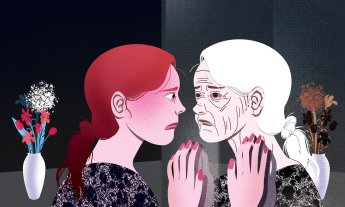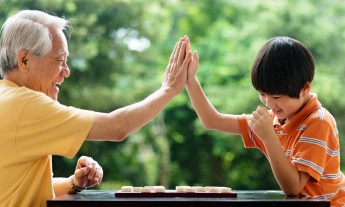
This post is part of TED’s “How to Be a Better Human” series, each of which contains a piece of helpful advice from people in the TED community; browse through all the posts here.
It was recently my birthday. It wasn’t a “big” birthday — one of those round-numbered ones that feels like a milestone — but nevertheless it got me thinking about aging.
When I was a kid, growing older felt like an achievement. Each year that passed marked one step closer to adulthood, which for me meant independence and freedom. I remember going to the city with my dad to see plays or go to the Met and seeing a group of women having lunch in a café. It seemed glamorous and exciting to be an adult. I couldn’t wait.
Likewise, I never quite understood the popular antipathy toward old age. At Spencer’s, a novelty store at the Galleria Mall in White Plains where my friends and I would find gag gifts, I was always perplexed by the section of “Over the Hill” merchandise. I mean, my grandparents didn’t listen to my music or play Nintendo with me, but they were cool in their own way — not crusty and out of touch like the caricatures suggested. The geezer jokes and “lying about your age” punchlines that adorned the mugs and t-shirts there seemed to come from another world, one that didn’t make sense to me.
In my 20s and 30s, friends would casually toss around the phrase “We’re so old!” I rolled my eyes. We were so young, I felt, and why should we waste that youth focused on what was already behind us? After all, right at that moment we were the youngest we would ever be.
My 20s were miles better than my teens — more expansive, less cloistered — and my 30s better than my 20s. I became more confident in my 30s, I got into therapy and dealt with years of childhood trauma, I learned to communicate my needs and be more mindful of the needs of others. I wouldn’t trade the growth of these past decades for fewer lines on my face or grey hairs on my head.
Author Heather Havrilesky wrote: “Growing old gracefully really means either disappearing or sticking around but always lying straight to people’s faces about the strength of your feelings and desires.”
Now that I’m in my 40s, though, aging isn’t some future concept. Just being alive means growing older, so yes, we’ve all been aging since we were born. But at a certain point, the notion of what life will be like in a couple of decades starts to feel more real, and then I start to reflect more on what my current choices mean for that future me.
I look back and wonder what my work-hard-play-hard 20s mean for me now. Could I have had a healthier body today if I had been kinder to it when I was younger? And could being gentler now give me more joy and freedom in the future?
The dominant discourse on aging, especially when it comes to women, revolves around “aging gracefully.” This generally involves looking at least three to five years younger than you actually are, while not appearing to do anything to get that way. It also means “acting your age,” by wearing age-appropriate clothes (mini skirts have an expiration date, apparently), having age-appropriate hair and doing age-appropriate activities — but maybe doing one or two surprisingly youthful things (surfing, maybe, or tap dancing) that don’t seem like you’re trying too hard yet let people know you’re still in the game.
As author Heather Havrilesky writes in her biting essay on the topic, “I think about how growing old gracefully really means either disappearing or sticking around but always lying straight to people’s faces about the strength of your feelings and desires.”
The only way to age and be deemed acceptable is to have lucky genes or to conceal your battles against time underneath a practiced smile.
“Aging gracefully” entails walking a tightrope between a youth-obsessed society, which tells us that our value declines as we age, and a culture that says nothing is as uncool as desperation, the fervent desire for something we can’t have. Marketers stoke our desire for youthfulness as the ticket to remaining relevant, then shame us when our efforts to preserve that youth go awry.
So the person who ages without thought to their appearance is written off as “having given up,” and the one whose face remains 35 forever thanks to the surgeon’s knife is considered a joke, and the only way to be deemed acceptable is to have lucky genes or to conceal your battles against time underneath a practiced smile. It all sounds exhausting, doesn’t it?
And so I’ve been thinking about how we move beyond this damaging — and frankly misogynistic — frame. What if instead of seeing aging as something to defeat and conquer, we were to embrace what gets better with age, and work to amplify these joys while mitigating the losses of youth? I’m not suggesting we paper over the very real challenges, both physical and mental, that come with aging. But can we view these challenges without judgment or shame and instead look for joyful ways to navigate them?
I delved into the research on aging, and here are 8 insights I’ve found that can help us think about joyful ways to feel well as we grow older.
1. Seek out awe
In a study of older adults, researchers found that taking an “awe walk,” a walk specifically focused on attending to vast or inspiring things in the environment, increased joy and prosocial emotions (feelings like generosity and kindness) more than simply taking a stroll in nature. Interestingly, they also found that “smile intensity,” a measure of how much the participants smiled, increased over the eight-week duration of the study. These walks were only 15 minutes long, once a week, and are low impact, so this is an easy way to create more joy in daily life as we age.
Practiced joyspotters well know the power of attending to joyful stimuli in the environment to boost mood. This study suggests that tuning our attention specifically to things that invoke wonder and awe can have measurable benefits, especially for older adults.
2. Get a culture fix
A 1996 study of more than 12,000 people Sweden found that attending cultural events correlated with increased survival, while people who rarely attended cultural events had a higher risk of mortality. Since then, a raft of studies (a good summary of them here) has affirmed that people who participate in social activities such as attending church, going to the movies, playing cards or bingo, or going to restaurants or sporting events is linked with decreased mortality among older adults. One reason may be that these activities increase social connection, deepen relationships, and reinforce feelings of belonging, which are positively associated with well-being. Cultural activities also help keep the mind sharp. While the pandemic has made this one challenging, as things start to open up again, getting a culture fix can be an easy way to age joyfully.
Enriching your environment with color, art, plants and other sensorially stimulating elements may be a worthwhile investment not just for protecting your mind as you age, but also your joy.
3. Stimulate your senses
One of the most talked-about parts of my TED Talk is when I describe my experience spending a night at the wildly colorful Reversible Destiny Lofts, an apartment building designed by the artist Arakawa and the poet Madeline Gins, who believed it could reverse aging.
The idea that an apartment could reverse aging sounds farfetched, but it becomes more grounded when we look at the theory behind it. Arakawa and Gins believed that just as our muscles atrophy if we don’t exercise them, our cognitive capacity diminishes if we don’t stimulate our senses. They looked at our beige, dull interiors and imagined that these spaces would make our minds wither. And as it turns out, some early research in animals (see also) suggests there might be something to this. When mice are placed in “enriched environments” with lots of sensorial stimuli and opportunities for physical movement, it mitigates neurological changes associated with Alzheimer’s and dementia. While there is some evidence to suggest that this might apply to humans as well, the mechanisms behind this phenomenon are not yet well understood.
That said, we do know that the acuity of our senses declines with age. The lenses of our eyes thicken and tinge more yellow, allowing less light into the eye. Our sense of smell, taste and hearing also become less sharp. So, while you don’t have to recreate Arakawa and Gins’s quirky apartments, enriching your environment with color, art, plants and other sensorially stimulating elements may be a worthwhile investment not just for protecting your mind as you age, but also your joy.
4. Buy yourself flowers
As if you needed an excuse for this one, but just in case, here you go. A study of older adults found that memory and mood improved when people were given a gift of flowers, which wasn’t the case when they were given another kind of gift.
Why would flowers have this effect? One reason may link to research on the attention restoration effect, which shows that the passive stimulation we find in looking at greenery helps to restore our ability to concentrate. Perhaps improved attention also results in improved memory. Another possibility, which is pure speculation at this point, relates to the evolutionary rationale for our interest in flowers. Because flowers eventually become fruit, it would have made sense for our ancestors to take an interest in them and remember their location. Monitoring the locations of flowers would allow them to save time and energy when it came to finding fruiting plants later, and potentially reach the fruit before other hungry animals. I have to stress that there’s no evidence I’m aware of to support this explanation, but it’s an intriguing possibility.
Taking it a step further, research has also shown that gardening can have mental and physical health benefits for older adults. So whether you buy your flowers or grow them, know that you’re taking a joyful step toward greater well-being in later life.
There’s something joyful about a mini time warp — maybe it’s revisiting a vacation spot you once loved or maybe it’s a getaway with friends where you banish talk of present-day concerns.
5. Try a time warp
In 1981, Harvard psychologist Ellen Langer ran an experiment with a group of men in their 70s that has come to be known as “the counterclockwise study.” For five days, they lived inside a monastery that had been designed to look just like it was 1959. There were vintage radios and black-and-white TVs instead of cassette players and VHS. The books that lined the shelves were ones that were popular at the time. The magazines, TV shows, clothes and music were all throwbacks to that exact period.
But these men weren’t just living in a time warp. They also had to participate. They were treated like they were in their 50s, rather than their 70s. They had to carry their own bags. They discussed the news and sports of 22 years earlier in the present tense. And to preserve the illusion, there were no mirrors and no photos, except of their younger selves.
At the end of five days, the men stood taller, had greater manual dexterity, and even better vision. Independent judges said they looked younger. A touch football game broke out among the group (some of whom had previously walked with a cane) as they waited for the bus home. Langer was hesitant to publish her findings, concerned that the unusual method and small sample size might be hard for the academic community to accept. But in 2010, a BBC show recreated the experiment with aging celebrities to similar effect. Langer’s subsequent research has led her to conclude that we can prime our minds to feel younger, which in turn can make our bodies follow suit.
While it might be difficult to recreate Langer’s study in our own lives, I think there’s something joyful about a mini time warp. Maybe it’s revisiting a vacation spot you once loved, and steeping yourself in memories from an earlier time. Maybe it’s a getaway with friends where you banish all talk of present-day concerns. Maybe it’s finding a book or a stack of old magazines from back then and reading them while listening to throwback tunes.
It’s also worth noting that a control group from the counterclockwise study who simply reminisced about their youth, without using the present tense, did not experience the same dramatic results — so these “mini time warps” may be more for fun than for tangible benefit. But even if you don’t turn back the clock, checking back in with your younger self can be a way to rediscover parts of yourself that you may have lost touch with and bring them with you as you age.
6. Maximize mobility
Exercise is often touted as a way to stay healthy and vibrant at any age, but one finding that makes it particularly relevant as we get older is that movement has been shown in studies to increase the size of the hippocampus, a part of the brain that plays a vital role in learning and memory. This is important because the hippocampus shrinks as we age, which can lead to memory deficits and increased risk of dementia. In one study of older adults, exercise increased hippocampus size by 2 percent, which is equivalent to reversing one to two years of age-related decline.
In addition to its cognitive effects, movement itself can be a source of joy. The ability to swim, hike, dance and play can be conduits to joy well into our older years. When I struggle to get motivated to exercise, I often think about my future self and how investing in my mobility now can help preserve range of motion and minimize repetitive stress injuries later. Simply put: you have one body, and it has to last your whole life. The more you do now to care for it, the more freedom you’ll have to do the things you love late in life.
As we age, we have a choice: We can either cling to the world as we shaped it and refuse to engage in the new world that kids are creating, or we can adapt to their world and remain curious, active participants.
7. Refeather your nest
Once you start looking at negative tropes around aging, you start seeing more and more of them. Take the phrase “empty nest,” which carries strong connotations of loss and deprivation. Though I’m at the stage where my nest suddenly just became quite full, I love the idea of reframing the “empty nest” into something more joyful.
One of my readers, Lee-Anne Ragan, offers up as a joyful process in the wake of children going off to start their own independent lives. She points out that the idea of an empty nest suggests that there’s nothing left, while refeathering takes a more ecological lens, imagining a kind of regeneration that happens as the home, and the family, transforms into something new. A refeathered nest is a place of possibility, creativity and delight.
8. Stay up on tech
While technology is often blamed for feelings of isolation, some studies show that for older adults, being technologically facile can offer a boost to well-being. One reason is that internet use may serve a predictor of social connection more broadly, and social connection is one of the most important contributors toward mental health and well-being throughout life, but especially in old age. Other studies suggest that when older adults lack the skills to be able to use technology effectively, it leads to a greater sense of disconnection and disempowerment and that offering training to older adults on technology can promote cognitive function, interpersonal connection and a sense of control and independence.
I’ve often been tempted, when a radically new app or device comes out, to say “That’s for the kids,” and ignore it. With free time so scarce, exploring new tech feels less appealing than digging into one of the books piled up on my nightstand. And anyway, unplugging is supposed to be good for us, right? But technology shapes the world we live in, and those technologies that seem new and fringy in the moment often end up in the mainstream, influencing the ways we communicate, work and access even basic services.
I remember trying to teach my grandmother how to use email. She was someone who never wanted to bother anyone, and I thought that email’s asynchronous communication would be good for her. Instead of calling, she could just send a note and know that she wasn’t interrupting anyone. She tried, but she struggled to learn it. She had stopped caring about technology long before that, and the leap to figure out how to use a computer was too great. Small choices not to engage with a new technology don’t matter much in the moment, but once you get a few steps down the road to disconnection, it can feel intimidating to try to plug back in.
Staying engaged with new technologies doesn’t have to be a burden. It might simply mean saying yes when a niece or nephew invites you play Minecraft or opening a TikTok account just to check it out. You don’t have to master every new app or tool, but being comfortable with new developments can help you ensure you don’t end up feeling helpless or blindsided when the tech you rely on every day changes.
I think a lot about something psychologist Alison Gopnik said when I interviewed her for the Joy Makeover a couple of years ago. She said that each new generation breaks paradigms and overturns old ways of doing things as a matter of course. This isn’t gratuitous — it’s how we move forward as a society. Each generation of kids will remake the world, and from this we’ll gain all kinds of new discoveries. So as we age, we have a choice: we can either cling to the world as we shaped it and refuse to engage in the new world our kids’ and grandkids’ generations are creating, or we can adapt to their world and remain curious, active participants in it.
This to me is at the heart of aging joyfully. Our goal shouldn’t be to cling to youth as we get older, but to keep our joy alive by tending our inner child throughout our days while also nurturing our connection to the changing world. In doing so, we balance wisdom with wonder, confidence with curiosity and depth with delight.
This post was first published on Ingrid Fetell Lee’s site, The Aesthetics of Joy.
Watch her TED Talk now:














